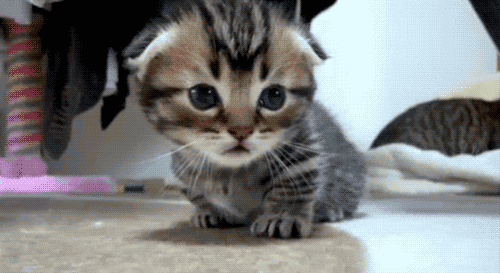Cats

The wildcat (Felis silvestris lybica) is the ancestor of the house cat we see today. Cats’ (Felis catus) domestication process began 12,000 years ago, and they are now considered the second most popular pet in the United States. In the wild, a cat’s diet would mostly consist of meat, and while a pet cat does not exert nearly as much energy to obtain its meals, its nutritional requirements are very similar to its counterpart; to maintain a domestic cat in ideal health, it is necessary to maintain an appropriate diet. Proper nutrition is only a part of a cat’s daily needs; observing a cat to understand its behavior will certainly enhance the pet-owner connection.
Cats can be mysterious creatures and will display odd mannerisms that may confuse their owners; let’s take a look at some of these.
- Slow blinking: Cats will slowly blink at their owners and/or other cats in order to show affection. To let your cat know you love it, return the gesture by slowly blinking back.
- Rolling on their back: Cats often show this behavior when they trust their owners, as this indicates that they feel very secure in their company. Take note that while this action may seem like an invitation for a belly rub, cats often prefer that you avoid this sensitive/unprotected section of their bodies.
- Kneading with their front paws: Cats mark their territory and/or show affection with kneading. Responding with gentle scratches behind their ears may be appreciated.
- Tail wagging: It is very important to understand that a cat wagging its tail is a sign of aggression and it may retaliate if the perceived offensive behavior is not stopped.
- Meowing: For cats, meowing is not generally directed towards other cats, but is primarily used to communicate with humans. Cats will meow to obtain attention and/or food from you.
- Wrapping its tail around its owner: Cats wrap their tails around their owners to show affection. You may respond with slow blinking, pets, and/or gentle scratches.
- Hissing at owner/cat: Cats will hiss at their owner or another cat because they feel threatened. When your cat hisses at you, the best course of action is to remove yourself from its surroundings so it is able to calm down.
- Puffing up their fur: Cats will puff up their fur when they are cold or when they are scared - puffed fur will make the animals seem larger and more threatening than they really are.
- Purring: Cats often purr when they feel safe and happy, although they will also purr when they want food. When in pain, they will also purr, as studies have shown that their purring has specific frequencies that aid in healing injuries.

